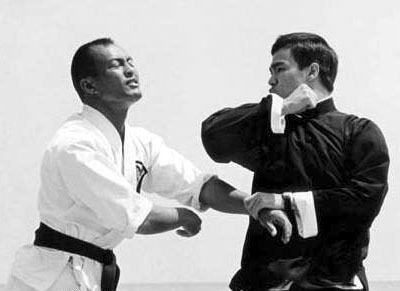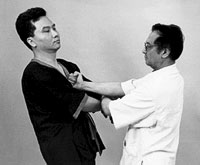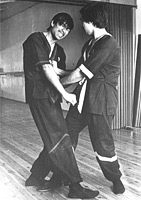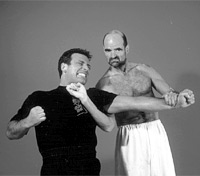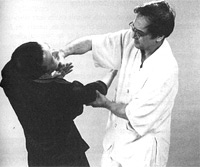|
|
|
RARE PUNCHES YIP MAN
FORGOT TO TEACH
By Dave Carter |
|
Had Bruce Lee been taught several rare wing chun punching techniques, he might not have needed to create jeet kune do. If Bruce Lee had known that there are actually two more ways of punching in the wing chun kung-fu system, he might not have needed to look elsewhere for answers to his fighting questions. As the story goes, Lee was a young upstart in San Francisco when he was challenged by an established master. Lee used his 'wing chun gung-fu', as he called it, but found it was too limiting to do the job. Subsequently, he entered his experimental stage which eventually led to the creation of jeet kune do. Lees's main complaint was that while plenty of his punches landed, few connected with the kind of force necessary to quickly end a fight.
More than one
According to grandmaster Dr. Leung Ting's WingTsun theories, the straight punch in WingTsun (wing chun) is the most popular attacking movement among all attacking strikes, but it is not the only punch in the system, as many continue to believe
"The problem is that during the lifetime of grandmaster Yip Man, he rarely gave deep explanations to his students in the common classes," Dr. Leung related. "You know, grandmaster Yip Man was a very traditional kung-fu instructor," he added. "In his way of thinking, if the students did not measure up to a certain standart to make him feel that they should be taught more about the application, he would not even explain to them the meaning or various functions of certain special movements."
"Also, the traditional wing chun concepts stressed a free-form approach to learning and free use of the techniques so the practitioner could adapt to myriad attacks. Therefore, wing chun instructors normally did not advocate a systematic way of teaching their students. Most traditional wing chun instructors either adopted a personal method or one that was accepted by their students."
Leaving out something
This method worked fine in another era when wing chun teachers accepted only a few disciples who remained with them a minimum of ten years. However, since grandmaster Yip Man became the first wing chun instructor to ever formally try to make a living from teaching martial arts, discrepancies occurred over time. Because of the "free" way of teaching, it was not uncommon for those with bigger classes to forget what techniques already had been covered. Subsequently, some students were taught complete sets while others only received portions of the complete curriculum.
This explains why so many top Yip Man students maintain, "I am the only one who had even learned this secret technique. No was else was taught what I know."
One of those students was Bruce Lee, who contended since he was only taught one straight punch that the wing chun system did not contain more. "The late grandmaster hardly provided explanation to his students that there was more than one way of punching," Dr. Leung Ting noted. "Further we cannot exclude the possibility that the late grandmaster even forgot to explain to most of his students the application of the rare punching techniques, even though they always have been part of the system's sets as Chum Kiu and Bil Tze."
"If the student did not measure up to a certain standard to make (Yip Man) feel they should be taught more about the application, he would not even explain to them the meaning of certain special movements."
"Even before I learned from grandmaster Yip Man, I also thought there were only two punches in the wing chun system (e.g., the straight punch in all the three kung-fu sets and the lifting punch in the middle section of the Chum Kiu set). It was not until I became his personal student that I discovered an additional hooking punch in the Bil Tze set."
"Due to this bad experience, when I started to teach in 1967, I felt that I had to change some of the traditional ideas or I would not be great in the future," Dr. Leung explained. "Actually, I did not change the traditional wing chun fighting concept; I only modified the teaching method and created a brand new grading system. And most importantly, I have enriched some of the techniques in the teaching courses to include the "missing" or "secret" techniques once through only to be known by a few men."
"I have also improved a few techniques so they could be applied not only against Chinese kung-fu opponents, but also for practitioners of any system. (Note:Before wing chun was introduced to the Western world, its purpose was to face those who practised only kung-fu.) To differentiate my system from the traditional varieties, I called it 'WingTsun'," he added.
Three methods WingTsun consists of three different punching methods: the straight punch, the lifting punch, and the hooking punch. Since the straight punch is applied all the time, it appears in all three kung-fu sets and is the system's most useful punching method.
The straight punch - (The character "sun" thrusting punch)
The "yat gi chung kuen" or character "sun" thrusting punch is the most important attacking movement in WingTsun. It is unique in the exertion of force compared to the straight punches of other martial arts. In launching a WingTsun straight punch, the main source of power is the elbow. There is a motto for the correct way of launching a WingTsun straight punch: "Keep the elbow at the centreline while you are launching a straight punch."
The first is pushed outward by a kind of special force called "explosive force". A good comparison is the firing of a cannon. The fist is the cannon ball, and the arm is like a rope with one end tied to the cannon ball, while the other is connected to the base (shoulder).
To make a powerful straight punch, you should also, "Not tighten up the muscles while you're punching." Tightening up the muscles is a big mistake for anyone seeking power. Although it may feel like tighter means of power, it is just an illusion. According to the WingTsun theory, a powerful punch is "a punch that lands on the opponent and causes him strong damage", so it is the opponent who feels the power and not the attacker.
Scientifically, it is the "extensors" (e.g., the triceps, etc.) which are responsible for giving a straight punch its power, not the "contractors" (e.g., the biceps). Therefore, if a man tightens up his muscles while launching a punch, it's like someone who tries to accelerate a car by putting on foot on the gas paddle and the other on the brake.
"We cannot exclude the possibility that the late grandmaster even forgot to explain to most of his students the application of the rare punching techniques."
There are three ways to use a straight punch.
1. The chain punch. The chain punch is regarded as the most practical and best attacking technique in the WingTsun system. A chain punch is a combination of a series of continuous alternating single punches. Once the left punch is launched, the right fist is held several inches in front of a WingTsun practitioner's chest waiting in an "on-guard" or ready position. When the left punch is straight, the right punch immediately darts out to the same position. At the same time the left hand withdraws and is placed in the original position in front of the chest to fill the gap, ready to fire again. This kind of alternate punching movements can be applied non-stop until the opponent is felled.
The chain punches in WingTsun can be compared to a "machine gun" with a non-stop attack. This is different from the single-punching way used by other martial styles, which favour a "one-shot" pistol approach in which you have to load a new bullet everytime.
2. The bouncing punch. At the end of the Chum Kiu set, there is a modified punching method which is a continuous movement combined with a "Gum-Sao" (pinning hand) and a straight punch. The action follows the downward Gum-Sao movement, which is supposed to nullify a frontal kick from an opponent. The defending hand then bounces up to form a half-arc and half-straight-line thrusting punch onto the opponent's face.
According to WingTsun theories, no matter how fast you move, "one movement is faster than two movements". Therefore, many WingTsun techniques are set to either use two hands to defend and counterattack simultaneously, or apply one continuous movement which normally takes a practitioner of other styles more than one movement to complete (e.g., first use one hand to block and then change to another hand to counterattack).
3. The double-punch. The double-punch is another modified punching method of the straight punch in WingTsun. Different from the alternating chain punches, the double-punch is applied at the same time with hands together landing separately on two different positions.
There are two different types of double-punch. The most common is the "vertical double-punch" in which a WingTsun man separately punches toward the upper and middle, or the middle and lower positions of his opponent at the same vertical midline of the front part of his opponent. This is different than the "combined double-punch", a double-punch using two fists close together which land on the same position (e.g., the pit of stomach). The double-punch is a modified attacking technique converted from the double Gaan-Sao movement in the Bil Tze set.
The lifting punch
Found in the middle section of the Chum Kiu set right after the three sideling Bong-Sao is a rare attacking movement called the "lifting punch". It is quite similar in shape to the uppercut in Western boxing. Unlike the uppercut, which moves from a lower position to the middle part (e.g., stomach, abdomen, etc.) or the higher position (e.g., lower jaw) of the opponent along a larger arc, the lifting punch moves out along a smaller arc from the middle level (e.g., chest) to the lower jaw position. The force of the lifting punch is also quite different from that of the uppercut.
The main source of the force comes from the turning stance combined with the twisting and lifting-up movement of the spine which adds in the elbow movement to "push" the fist along a small arc from down to up toward the lower jaw. The lifting up of the whole upperbody weight with the quick turning action is a main factor that forms a very powerful smashing force to crash up against the lower jaw position, considered one of the weakest body points.
The lifting punch can be applied when the opponent's head is bent forward or at the side of a WingTsun practitioner (e.g., when the opponent is doing a straight punch). It is difficult and ineffective for the WingTsun man to use the straight punch to continue attacking his opponent. At this moment, a lifting punch combined with a "neck-pulling hand" technique will become the best technique to overcome the opponent.
The hooking punch
Other than the lifting punch, there is another rare attacking technique found in the Bil Tze set. It is the "hooking punch" of the WingTsun system. Although the hooking punch looks similar to a "hook" in Western boxing, it is different in application of force. It is the turning of the stance plus the swinging movement of the arm that combine to create a powerful smash to the ear. There are also other variations of WingTsun punching techniques, for instance the "nail punch". The "nail punch" is a special punching technique which features the first joint of the first finger springing out to stab into the weakest and softest positions (e.g., throat, pit of the chest, abdomen, etc.), while the attacker's fist is landing on the opponent's body. The attack can be fatal.
|
|
Inside Kung-Fu /cover story - august 1994/ |
|
|
